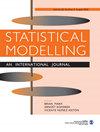新冠肺炎数据的统计建模:使广义加性模型发挥作用
IF 1.2
4区 数学
Q2 STATISTICS & PROBABILITY
引用次数: 2
摘要
在2019冠状病毒病大流行期间,已多次成功使用广义加性模型(GAMs)来获得重要的数据驱动见解。在本文中,我们将进一步证实GAMs的成功故事,通过重点关注三个与大流行病有关的问题,展示其灵活性。首先,我们研究了不同年龄组感染之间的相互依赖性,重点是学龄儿童。在这种情况下,我们推导了参数估计独立于(未知)病例检出率的设置,病例检出率在COVID-19监测数据中起着重要作用。其次,我们建立了住院率的模型,因为住院率的数据只具有时间延迟。我们说明了如何通过临近预报程序纠正这种报告延迟,可以作为抵消项自然地纳入GAM框架。第三,我们提出了重症监护病房(ICU)每周占用率的多项模型,其中我们区分了COVID-19患者,其他患者和空置床位的数量。通过这三个例子,我们旨在展示GAMs的实用性和“现成的”适用性,以从现实世界的数据中获得新的见解。本文章由计算机程序翻译,如有差异,请以英文原文为准。
Statistical modelling of COVID-19 data: Putting generalized additive models to work
Over the course of the COVID-19 pandemic, Generalized Additive Models (GAMs) have been successfully employed on numerous occasions to obtain vital data-driven insights. In this article we further substantiate the success story of GAMs, demonstrating their flexibility by focusing on three relevant pandemic-related issues. First, we examine the interdepency among infections in different age groups, concentrating on school children. In this context, we derive the setting under which parameter estimates are independent of the (unknown) case-detection ratio, which plays an important role in COVID-19 surveillance data. Second, we model the incidence of hospitalizations, for which data is only available with a temporal delay. We illustrate how correcting for this reporting delay through a nowcasting procedure can be naturally incorporated into the GAM framework as an offset term. Third, we propose a multinomial model for the weekly occupancy of intensive care units (ICU), where we distinguish between the number of COVID-19 patients, other patients and vacant beds. With these three examples, we aim to showcase the practical and ‘off-the-shelf’ applicability of GAMs to gain new insights from real-world data.
求助全文
通过发布文献求助,成功后即可免费获取论文全文。
去求助
来源期刊

Statistical Modelling
数学-统计学与概率论
CiteScore
2.20
自引率
0.00%
发文量
16
审稿时长
>12 weeks
期刊介绍:
The primary aim of the journal is to publish original and high-quality articles that recognize statistical modelling as the general framework for the application of statistical ideas. Submissions must reflect important developments, extensions, and applications in statistical modelling. The journal also encourages submissions that describe scientifically interesting, complex or novel statistical modelling aspects from a wide diversity of disciplines, and submissions that embrace the diversity of applied statistical modelling.
 求助内容:
求助内容: 应助结果提醒方式:
应助结果提醒方式:


